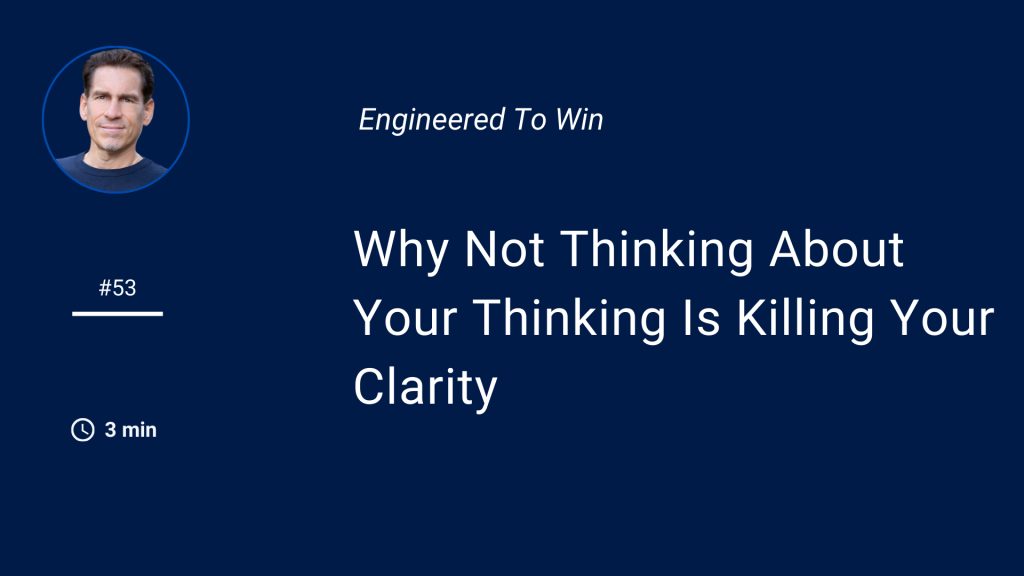Most CEOs pride themselves on being “decisive.” Move fast, break things, trust your gut.
But here’s the contrarian truth: if you’re not thinking about your thinking, you’re flying blind.
It’s like piloting a jet with no dashboard—lots of speed, zero awareness of whether you’re climbing toward progress or nosediving into chaos.
Socrates nailed this 2,400 years ago when he said, “The unexamined life is not worth living.” He wasn’t being poetic; he was giving us a manual for consciousness. A life without reflection is just biological clock-punching: eat, sleep, chase money, die.
The same applies to leadership. If you’re not examining how you think—your assumptions, defaults, and blind spots—you’re just reacting. And reactionary leadership is the fast lane to burnout, bad decisions, and missed opportunities.
The Science of Self-Reflection
Neuroscience calls this metacognition—the ability to step back and notice your own thoughts. It’s the “second layer” of awareness that separates you from autopilot.
Here’s why it matters:
- Performance: A 2014 study in Frontiers in Human Neuroscience found that metacognitive training improved problem-solving under stress.
- Bias Detection: Research from Cambridge showed that people with stronger metacognitive awareness were less prone to overconfidence bias (the trap CEOs fall into before markets humble them).
- Learning: A report from the NSW Department of Education confirms that metacognition is one of the strongest predictors of independent learning and critical thinking—skills that compound over time for leaders.
Translation: reflection isn’t soft. It’s a competitive edge.
How to Think About Your Thinking
Most leaders don’t lack intelligence. They lack metacognitive checkpoints. Here are three to install this week:
1. Pause Before You Pounce
Before making a major decision, ask: “What belief am I assuming here? What if the opposite were true?”
This alone can expose faulty logic. (Charlie Munger calls this inversion; I call it your insurance policy against dumb mistakes.)
2. Name the Narrator
Every thought has a “voice”—fear, ambition, ego, scarcity. Label it. “That’s fear talking.” “That’s status-seeking.” Naming creates distance, and distance creates power.
3. Daily Debrief
Take 5 minutes each night to ask:
- What was I thinking before my best decision today?
- What was I thinking before my worst?
Do this for 30 days and you’ll see the cognitive fingerprints of your success and sabotage. If you want a deeper system for doing this, see What Is Metacognitive Mapping? (And How It Transforms CEO Decision-Making).
Quick Action Challenge
Today, catch one thought and ask: “Is this mine—or did I inherit it?”
You’ll be shocked how many beliefs are hand-me-downs from parents, bosses, or culture. Not examining them is like running outdated software and wondering why your system crashes.
Expert Insight
Daniel Kahneman, Nobel Prize–winning psychologist, put it bluntly: “Nothing in life is as important as you think it is, while you are thinking about it.”
In other words, your mind constantly tricks you into overweighting the urgent and underweighting the meaningful. Metacognition is the only way out of this trap.
Closing Thought
One of my core beliefs: progress is a process, and patience is the pathway.
Reflection is not indulgence; it’s the operating system of high-performance leadership.
Ask yourself:
👉 Where are you leading from autopilot when you could be leading with awareness?
Recommended Tool
Try the app Daylio. It’s a micro-journaling tool that lets you quickly log moods and thoughts. Why it works: it externalizes your inner dialogue, creating the metacognitive “mirror” your brain needs to spot patterns.
Call to Action
If this landed, hit reply and share one belief you’ve realized wasn’t actually yours. Forward this to another founder who might be flying blind.

